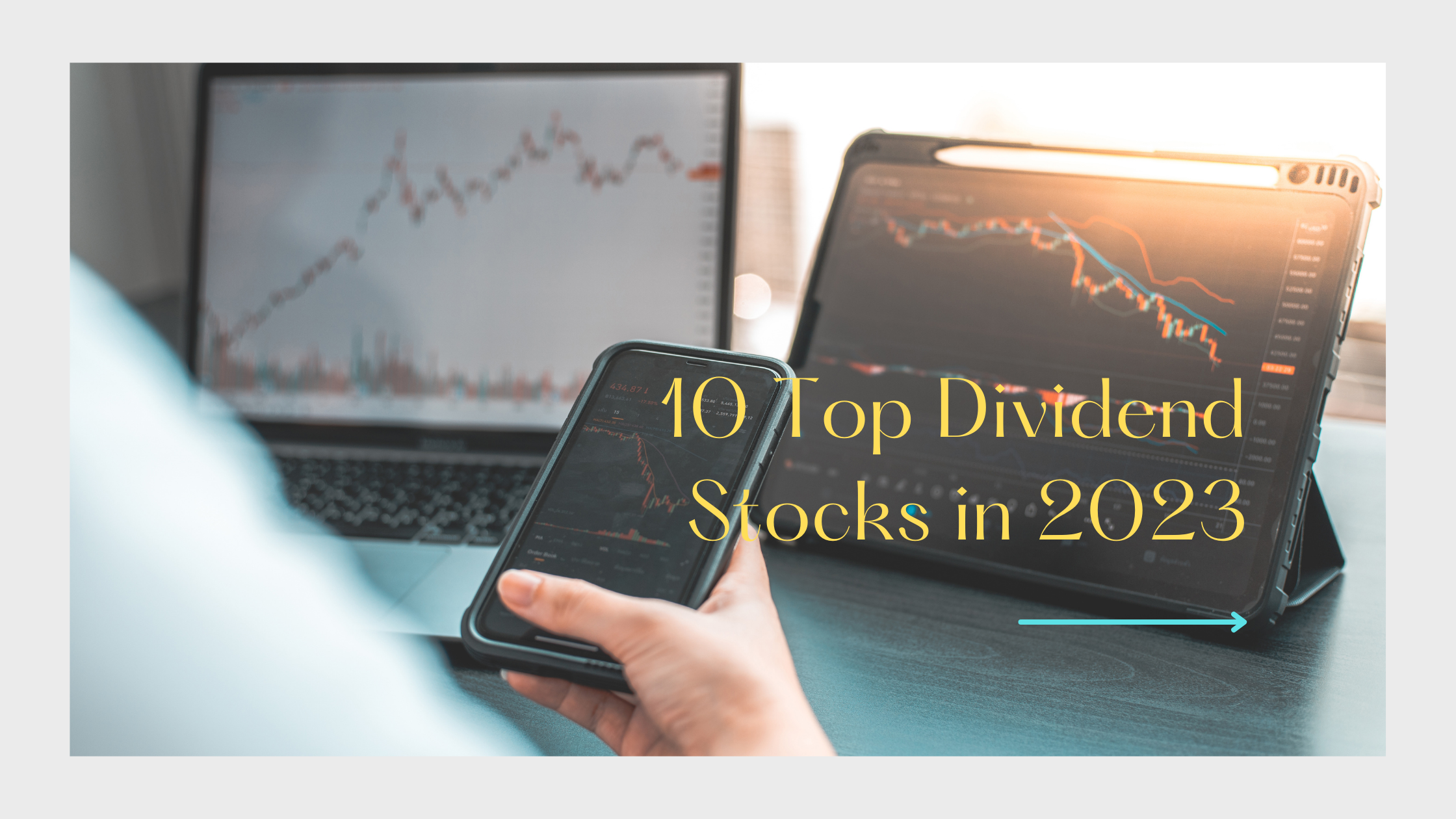Dividend investing has always been a powerful strategy to build wealth. It allows investors the ability to reap the rewards of regular payouts while utilizing the idea of compounding.
In this comprehensive guide, we will discuss the world of dividend stocks and explore how to select the right investments for your portfolio. We will also introduce you to the companies that have emerged as the 10 best dividend-paying stocks in 2023. These companies aren’t just symbols of financial stability; they are the engines driving the economy forward.
Whether you’re a seasoned investor or just starting on your investment journey, this guide will provide you with valuable insights, enabling you to make informed decisions in the world of finance.
The Benefits of Dividend Investing
When it comes to building wealth, dividend stocks have a special place for themselves in the world of investment. Let’s explore the many advantages that they bring to the table.
Passive Income and Long-Term Wealth-Building
One of the primary attractions of dividend investing is the steady stream of income it offers. Unlike growth stocks that rely on capital appreciation, dividend stocks pay out a portion of their earnings to shareholders in the form of dividends.
This consistent stream of income can be a financial game-changer, providing investors with the means to cover living expenses, reinvest in more shares, or simply enjoy a higher standard of living.
Besides the passive income aspect of dividend investing, the ability to create wealth over the long term is what makes dividend stocks so appealing. Reinvesting dividends can lead to what is known as “compounding.” Over time, your initial investment can grow exponentially, thanks to the power of compounding returns.
Think of it like a financial snowball, rolling downhill and gaining momentum and growing as it goes. This is why many successful investors consider dividend stocks as the cornerstone of their portfolios.
Stability During Market Fluctuations
Another remarkable aspect of dividend stocks is their ability to provide stability in turbulent market conditions. While the stock market can be a rollercoaster ride at times, dividend payments offer a degree of certainty and less risk.
Even during bear markets or economic downturns, companies that have a history of paying dividends tend to continue doing so, providing a reliable source of income for investors.
Overall, dividend stocks offer a unique blend of passive income and financial stability, making them an attractive choice for investors seeking both income and long-term wealth.
Factors to Consider When Choosing Dividend Stocks
Selecting the right dividend stocks might seem overwhelming, but there several key factors that can help and can also ensure a successful and profitable investment. Let’s explore these essential criteria.
1. Dividend Yield, Payout Ratio, and Dividend Growth
- Dividend Yield: The dividend yield is an indicator of a stock’s income potential. It is calculated by dividing the annual dividend amount by the stock’s current price. A higher yield implies a more substantial income relative to your investment. However, be cautious of exceptionally high yields, as they could be a sign of an unsustainable dividend or financial instability.
- Payout Ratio: The payout ratio reflects the percentage of a company’s earnings paid out as dividends. A lower payout ratio indicates that a company retains a significant portion of its earnings for growth and future dividends. Ideally, you’d want to look for stocks with a sustainable payout ratio, typically below 60-70% of earnings.
- Dividend Growth: Consistency in dividend payments is important, but so is growth. Stocks with a history of increasing dividends over time are often desirable. This demonstrates that the company is financially sound and can withstand economic fluctuations.
2. Assessing a Company’s Financial Health and Stability
- Earnings and Revenue Trends: Investigate a company’s earnings and revenue growth trends. Steady or increasing figures indicate a healthy business.
- Debt Levels: Excessive debt can strain a company’s ability to maintain dividend payments. Check the debt-to-equity ratio to assess the company’s financial leverage.
- Cash Flow: Strong and consistent cash flow is vital for sustaining dividends. It ensures that a company has the resources to meet its dividend obligations.
- Profit Margins: Healthy profit margins indicate a company’s ability to generate profits, which can fund dividend payments.
3. The Importance of Diversification in a Dividend Portfolio
- Industry Diversification: Avoid over-concentration in a single industry. Diversify across sectors to minimize the impact of sector-specific downturns.
- Stock Diversification: Invest in a range of dividend-paying stocks to spread risk. A diversified portfolio can weather individual stock underperformance.
- Global Diversification: Consider diversifying geographically by including international dividend stocks. This can further reduce risk and increase exposure to different economic conditions.
By considering these factors and conducting thorough research, you can build a robust portfolio of dividend stocks that not only provide a steady stream of income but also have the potential for long-term growth.
In the next section, we’ll dive into the exciting part… revealing the 10 best dividend-paying stocks of 2023.
The Top 10 Dividend-Paying Stocks of 2023
Without further ado, let’s explore the 10 best dividend-paying stocks of 2023. Each of these companies offers compelling opportunities for both income and growth. Here’s a brief introduction to each one:
1. Texas Instruments (TXN)
- Industry: Technology
- Why It Made the List: TXN has seen strong earnings growth and has steadily raised its dividend amount (averaging 14.9% yearly increases) over the last five years.
- Key Metrics: Dividend Yield: 3.3%, Payout Ratio: 63%
2. Merck & Company (MRK)
- Industry: Healthcare
- Why It Made the List: MRK is trading near all-time highs. It also has very high historical EPS growth.
- Key Metrics: Dividend Yield: 2.8%, Payout Ratio: 239%
3. The Hershey Company (HSY)
- Industry: Consumer Goods
- Why It Made the List: HSY has been steadily increasing their dividend amount by almost 10% per year. The stock is trading at an all time high and it’s EPS is steady.
- Key Metrics: Dividend Yield: 2.5%, Payout Ratio: 49%
4. Tractor Supply Company (TSCO)
- Industry: Agricultural Retail
- Why It Made the List: TSCO has an excellent track record for performance and is the largest retail operator of farm stores in the U.S.
- Key Metrics: Dividend Yield: 2.0%, Payout Ratio: 41%
5. Lockheed Martin Corporation (LMT)
- Industry: Aerospace Technology
- Why It Made the List: LMT has been growing EPS at more than 20% per year.
- Key Metrics: Dividend Yield: 3.0%, Payout Ratio: 46%
6. Broadcom Inc. (AVGO)
- Industry: Technology – Software
- Why It Made the List: AVGO has grown earnings more than 10.4% over the last five years.
- Key Metrics: Dividend Yield: 2.2%, Payout Ratio: 56%
7. Paychex (PAYX)
- Industry: Financial Services
- Why It Made the List: PAYX has a very high dividend yield and analysts expect their earnings to grow by 6.4% next year.
- Key Metrics: Dividend Yield: 2.7%, Payout Ratio: 75%
8. UnitedHealth Group (UNH)
- Industry: Health Insurance
- Why It Made the List: UNH has a high potential for growth as it currently insures over 152 million people.
- Key Metrics: Dividend Yield: 1.4%, Payout Ratio: 32%
9. Domino’s Pizza (DPZ)
- Industry: Food
- Why It Made the List: DPZ is the largest pizza chain in the United States. It’s earnings growth is expected to be 14.5% next year.
- Key Metrics: Dividend Yield: 1.2%, Payout Ratio: 33%,
10. Oracle Corporation (ORCL)
- Industry: Software
- Why It Made the List: ORCL’s EPS growth is expected to be 12.7% next year. It also has a payout ratio of 43.2% and stands to be able to keep increasing dividends.
- Key Metrics: Dividend Yield: 1.4%, Payout Ratio: 43%
These companies represent a diverse range of industries, each offering unique value to investors. As you can see from the key metrics and recent performance data, they present great opportunities for those seeking to invest in the best dividend stocks in 2023.
How to Invest in Dividend Stocks
So now that you know the top 10 dividend stocks for 2023, how do you go about investing in them? This section provides a step-by-step guide on how to get started with dividend investing.
1. Opening a Brokerage Account
- Choose a Broker: Research and select a reputable online brokerage platform. Look for a broker that offers a user-friendly interface, reasonable fees, and access to the stocks you’re interested in. Here are a few trustworthy platforms:
- Robinhood – one of the easiest to use!
- ETrade
- Fidelity
- TD Ameritrade
- Webull
- Complete the Application: Once you’ve chosen a brokerage, you’ll need to fill out an application. This typically involves providing personal information, financial details, and agreeing to the terms of the account.
- Fund Your Account: After your account is approved, you’ll need to deposit money into it. This is the capital you’ll use to purchase dividend stocks.
2. Purchasing Dividend Stocks
Now that you have a brokerage account, it’s time to buy dividend stocks. Here are two common ways to do this:
- Market Orders: A market order is an instruction to buy a stock at the current market price. This method is quick and ensures that you’ll acquire the stock, but it may not guarantee a specific purchase price.
- Limit Orders: With a limit order, you set a specific price at which you’re willing to buy a stock. The order will only execute if the stock’s price reaches or falls below your specified limit. This approach gives you more control over your purchase price.
3. Portfolio Management and Monitoring
Investing in dividend stocks isn’t a “set it and forget it” strategy. To optimize your investment, it’s essential to manage and monitor your portfolio regularly. Here’s how:
- Diversify: As mentioned earlier, diversification is key. Spread your investments across different industries to reduce risk.
- Reinvest Dividends: Many brokerage platforms offer automatic dividend reinvestment programs (DRIPs). This allows you to reinvest your dividend income back into the same stocks, compounding your returns.
- Stay Informed: Keep an eye on your investments. Monitor company news, financial reports, and market trends. Adjust your portfolio as needed based on your financial goals and the performance of your stocks.
- Review Your Strategy: Periodically review your investment strategy. As market conditions change, your goals may evolve. Be prepared to adapt your approach accordingly.




